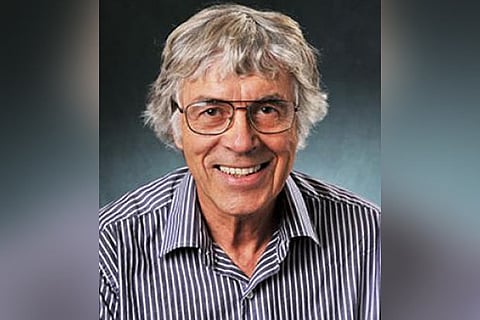Visa denial irks US scientist
Bengaluru
A world-renowned US geophysicist is highly disappointed that India denied him a visa to attend a three-day international conference at the Indian Institute of Technology (IIT) in Mandi, Himachal Pradesh, that began on Thursday.
Roger Bilham, a professor of geology at the University of Colorado, had been invited by the organisers to deliver the plenary address at the International Workshop on Climate Change and Extreme Events in the Himalayan Region.
"I am on a list," Bilham told this correspondent in an email on the denial of a visa. "I have been told the list includes terrorists, journalists and activists. As far as I know I am the only scientist on this list. They have not told me why I am on this list. The whole thing is truly shameful."
This is not the first time India denied Bilham a visa. On May 19, 2012, on arrival at the Indira Gandhi International Airport in New Delhi, en route to Bhutan, he was denied entry and sent back to the US.
At that time Bilham believed his deportation was a reaction to his publications bringing to light seismic risks to Jaitapur in Maharashtra, the site of a proposed nuclear power plant.
Bilham's deportation at that time prompted prominent geologists from the US, France and Switzerland to petition the Indian government to reconsider Bilham's banishment.
"But there has been no change in my status," Bilham said in his email. "I have twice applied for a visa and, after payment of $450, have been refused one."
Bilham has published numerous articles on the tectonics of the Indo-Asian collision, and the history of earthquakes in India. He had been invited because "his years of research forms the basis for the current knowledge about earthquakes in the Himalayan region", the organisers said in a press release.
Bilham's assessment that a magnitude-8.7 earthquake could strike in the Kashmir Himalayas - more than 10 times stronger than the widely accepted upper bound of magnitude 8 - has irked some in the Indian disaster management community.
The seismic warnings on Jaitapur and Kashmir, Bilham thought, were probably interpreted as "scare mongering" and hence he was black-listed.
"On this occasion (for the conference at IIT-Mandi), its convener Ramesh Singh had hoped to persuade the Ministry of Home Affairs that I should be issued with a visa to give this important talk," he said. "But this too did not work."
Home Ministry spokesman for visa enquiries Pramod Kumar (Director-F) did not reply to this correspondent's request for the reason Bilham was denied a visa.
Since Bilham could not be physically present at the workshop, he delivered a video lecture instead.
"Bilham could not be physically present as he did not get the visa," Ramesh Singh told this correspondent on the phone. "So he delivered a video lecture on 'Future great earthquakes in the Himalayas' to a wide audience."
According to its organisers, the workshop, being attended by researchers from 10 countries, aims at understanding the effects of climate change, melting of glaciers, increased frequency of extreme events like glacial lake outbursts and pollution due to burning of crop residue on the Himalayan region and applications of remote sensing.
"It provides a platform for scientists and academicians from various national and international institutes to share knowledge for the overall goal of capacity building in the field of earth sciences," Ramesh Singh said.
Last month, Bilham had cautioned - in a new analysis published by the Geological Society of London - that "currently two-thirds of the Himalayas is poised to rupture in one or more great earthquakes." and that the death toll from a future earthquake in the Himalaya "could possibly exceed 100,000".
Visit news.dtnext.in to explore our interactive epaper!
Download the DT Next app for more exciting features!
Click here for iOS
Click here for Android

